Marcia Thornton Jones's Blog, page 161
November 14, 2015
RU Recipe by Bob Krech
I loved my time as a college student at Rutgers and I am a loyal son even through the recent nationally publicized debacles and resultant black eyes affecting the basketball and football teams. RU has many diverse and notable alumni including Paul Robeson, James Gandolfini, Milton Friedman, Ozzie Nelson, children's (and adult) writer Judith Viorst and believe it or not, Mr. Magoo.
One alumni whose work I have been reading lately is chef Mario Batali. While he was at Rutgers he learned his cooking at a local student hangout known as "Stuff Yer Face." Now of course, he is all over the world with his TV shows, cook books, and restaurants. I have been doing more of the cooking lately around our house and I recently found a pretty healthy (no frying) and easy Eggplant Parmigiana from Mario. I hope you enjoy it as much as we do.
Ingredients
Extra-virgin olive oil
2 large eggplant, about 2 pounds
salt and pepper
2 cups tomato sauce
1 bunch fresh basil leaves, chiffonade
1 pound fresh mozzarella, sliced 1/8 inch thick
1/2 cup grated parmigiano cheese
1/4 cup fresh bread crumbs, lightly toasted under broiler
Directions
Preheat oven to 450 degrees F.
Using some extra-virgin olive oil, oil a baking sheet
Slice eggplant into 6 pieces about 1 to 1 1/2 inches thick
Lightly season each desk with salt and pepper and place on the oiled sheet
Bake the eggplant at 450 degrees F until the slices begin turning deep brown on top, about 12-15 minutes.
Remove eggplants from oven and place them on a plate to cool.
Lower oven temperature to 350 degrees F. In an 8 x 12 brownie pan, place the 4 largtest eggplant slices evenly spaced apart.
Over each slice, spread 1/4 cup of tomato sauce and sprinkle with a teaspoon of basil.
Place one slice of mozzarella over each and sprinkle with 1 teaspoon grated parmigiano.
Place the smaller slices of eggplant over each of the disks and repeat with tomato sauce, basic, and the 2 cheeses.
Repeat the layering again until all the ingredients are used.
Sprinkle the toasted bread crumbs over the top of the eggplant dish, and bake uncovered until the cheese melts and tops turn light brown, about 20 minutes. Serve immediately.
One alumni whose work I have been reading lately is chef Mario Batali. While he was at Rutgers he learned his cooking at a local student hangout known as "Stuff Yer Face." Now of course, he is all over the world with his TV shows, cook books, and restaurants. I have been doing more of the cooking lately around our house and I recently found a pretty healthy (no frying) and easy Eggplant Parmigiana from Mario. I hope you enjoy it as much as we do.
Ingredients
Extra-virgin olive oil
2 large eggplant, about 2 pounds
salt and pepper
2 cups tomato sauce
1 bunch fresh basil leaves, chiffonade
1 pound fresh mozzarella, sliced 1/8 inch thick
1/2 cup grated parmigiano cheese
1/4 cup fresh bread crumbs, lightly toasted under broiler
Directions
Preheat oven to 450 degrees F.
Using some extra-virgin olive oil, oil a baking sheet
Slice eggplant into 6 pieces about 1 to 1 1/2 inches thick
Lightly season each desk with salt and pepper and place on the oiled sheet
Bake the eggplant at 450 degrees F until the slices begin turning deep brown on top, about 12-15 minutes.
Remove eggplants from oven and place them on a plate to cool.
Lower oven temperature to 350 degrees F. In an 8 x 12 brownie pan, place the 4 largtest eggplant slices evenly spaced apart.
Over each slice, spread 1/4 cup of tomato sauce and sprinkle with a teaspoon of basil.
Place one slice of mozzarella over each and sprinkle with 1 teaspoon grated parmigiano.
Place the smaller slices of eggplant over each of the disks and repeat with tomato sauce, basic, and the 2 cheeses.
Repeat the layering again until all the ingredients are used.
Sprinkle the toasted bread crumbs over the top of the eggplant dish, and bake uncovered until the cheese melts and tops turn light brown, about 20 minutes. Serve immediately.
Published on November 14, 2015 23:30
Recipe for Writing a Recipe Poem November Theme by Tamera Wissinger
When I wrote my first book, Gone Fishing: A Novel in Verse, I included a poem called Recipe for Fishing. In it the main character, Sam, explains the ingredients needed to go fishing. The recipe p0em is really a how-to poem and is a fun way to express a topic that isn’t necessarily about food, so in honor of this month’s theme I’d like to share my Recipe for Writing a Recipe Poem.
Happy Thanksgiving, and happy recipe poem writing!

~~~~~Tamera Wissinger writes stories and poetry for children including Gone Fishing: A Novel in Verse, This Old Band, and the forthcoming There Was An Old Lady Who Gobbled a Skink and Gone Camping: A Novel in Verse. Tamera loves recipes – both the traditional kind and the poetic. You can connect with Tamera online at her website, on Twitter, or on Facebook.
Happy Thanksgiving, and happy recipe poem writing!

~~~~~Tamera Wissinger writes stories and poetry for children including Gone Fishing: A Novel in Verse, This Old Band, and the forthcoming There Was An Old Lady Who Gobbled a Skink and Gone Camping: A Novel in Verse. Tamera loves recipes – both the traditional kind and the poetic. You can connect with Tamera online at her website, on Twitter, or on Facebook.
Published on November 14, 2015 05:00
November 12, 2015
One Recipe...For Success as a Writer...and For a Treat.
When I meet fellow writers who aren't published yet, I'm often asked how did it happen. How did I get a book published? Just like there are many "recipes" for fruit bars (see below), there is more than one path to getting a book published.
But whether you choose to self-publish or go the traditional route, there is one thing I've learned to appreciate as an author...the power of persistence. The old addage..."if at first you don't succeed...try, try again" holds true. Learn from rejections, hone your skills as a writer with editing and learning craft, and get back on the writing horse and try again. If you are serious about improving and really work to make your novel or story shine, you will get published...eventually.
So while you're working on the new NaNoRiMo draft or something else, fortify your soul with some yummy DATE BARS. And Have a Happy Thanksgiving.
OATMEAL FRUIT BARS Filling: I C. of dried fruit. (I used dates. You can also use cherries, apricots or raisins.)½ C. granulated sugar. 1 C. water. 1-1/2 tsp grated lemon peel.Crust: 1 ½ C. flour ( I used whole wheat and regular)2/3 C dark brown sugar. 1 ½ C. old fashioned or quick cook oatmeal (not instant).½ C. chopped walnuts. 2 sticks melted butter ( or you can use 1 stick butter and ½ C canola oil)
1. Heat oven to 350 degrees. Line an 8 x 8 inch pan with foil. Grease or spray foil with non-stick spray.2. Filling: Place diced fruit, sugar and water in a saucepan over medium heat (NOTE: parents should assist children with this step). Bring to a boil, stirring occasionally. Cook for 12-15 minutes, until thick. Watch carefully toward the end; mixture may bubble and splash! Stir in lemon peel. Cool to lukewarm.3. Crust: Mix the dry ingredients in a medium bowl. Stir in melted butter until well blended.4. Remove one C. of crust mixture for later. Pressthe remaining amount evenly into the bottom of the prepared pan. Spread the fruit mixture over this. Then Sprinkle the reserved crumb topping evenly. Press gently into an even layer.5. Bake 40-45 minutes or until bubbles form around the edges of the pan. Cool on a rack 45 minutes, then cover and cool in refrigerator at least 4 hours. 6. Turn onto a cutting board. Peel off foil. Cut into bars with a sharp knife. These bars can be stored in the refrigerator in an airtight container for a couple weeks.
But whether you choose to self-publish or go the traditional route, there is one thing I've learned to appreciate as an author...the power of persistence. The old addage..."if at first you don't succeed...try, try again" holds true. Learn from rejections, hone your skills as a writer with editing and learning craft, and get back on the writing horse and try again. If you are serious about improving and really work to make your novel or story shine, you will get published...eventually.
So while you're working on the new NaNoRiMo draft or something else, fortify your soul with some yummy DATE BARS. And Have a Happy Thanksgiving.
OATMEAL FRUIT BARS Filling: I C. of dried fruit. (I used dates. You can also use cherries, apricots or raisins.)½ C. granulated sugar. 1 C. water. 1-1/2 tsp grated lemon peel.Crust: 1 ½ C. flour ( I used whole wheat and regular)2/3 C dark brown sugar. 1 ½ C. old fashioned or quick cook oatmeal (not instant).½ C. chopped walnuts. 2 sticks melted butter ( or you can use 1 stick butter and ½ C canola oil)
1. Heat oven to 350 degrees. Line an 8 x 8 inch pan with foil. Grease or spray foil with non-stick spray.2. Filling: Place diced fruit, sugar and water in a saucepan over medium heat (NOTE: parents should assist children with this step). Bring to a boil, stirring occasionally. Cook for 12-15 minutes, until thick. Watch carefully toward the end; mixture may bubble and splash! Stir in lemon peel. Cool to lukewarm.3. Crust: Mix the dry ingredients in a medium bowl. Stir in melted butter until well blended.4. Remove one C. of crust mixture for later. Pressthe remaining amount evenly into the bottom of the prepared pan. Spread the fruit mixture over this. Then Sprinkle the reserved crumb topping evenly. Press gently into an even layer.5. Bake 40-45 minutes or until bubbles form around the edges of the pan. Cool on a rack 45 minutes, then cover and cool in refrigerator at least 4 hours. 6. Turn onto a cutting board. Peel off foil. Cut into bars with a sharp knife. These bars can be stored in the refrigerator in an airtight container for a couple weeks.

Published on November 12, 2015 06:00
November 11, 2015
On Strudel
(Warning: Extended Metaphor Ahead)from Jody Feldman I’d decided. For an upcoming family event, I was going to make my grandmother’s strudel. I embarked upon this mission in sort of the same way I went about writing my first novel—semi-blind.
I had happened, once, on my grandmother while she was making strudel, and I had sort of helped my mom do this a couple times, but I’d never taken part in the process from beginning to delicious end. With neither of them here to guide me, I struck out on my own.
I had a recipe, sure. Like many complicated recipes passed down from generation to generation, though, I had an ingredient list and I had an outline of steps, but the important details were missing. (I was lucky actually. Some of my grandmother’s recipes are ingredient lists only.)
I jumped into the process this past Sunday.
The filling was easy; just mix up everything then adjust for taste. It was the dough, the part that held it all together, that would be the ultimate challenge. The thin layers that wrap around the filling start out as flour and water and other ingredients which you mix then let sit for an hour. I won’t go into details, but here’s my first batch of dough.
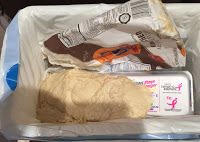
I needed to figure out where I went wrong.
I took a shower.
And as showers often do, this one worked again. Thinking about my grandmother’s simple instructions—knead dough, divide into thirds, brush with oil, and rest on board for 60 minutes—I realized that similar to bread dough (though this has no yeast), she must have kneaded in more flour than the recipe called for. I probably worked in at least another cup, and this batch had substance. Again, I let it rest to prepare for what was to come.

That one time I walked into my grandmother’s apartment, I couldn’t comprehend how such a small ball of dough could eventually be stretched enough to hang over the edges of her kitchen table like a second tablecloth. And now it was my turn to coax my ball of dough into the same thinness. As it grew and grew and took the shape it needed, I was suddenly struck by the fact that, underneath it all, I began to see the pattern of the tablecloth, one that’s older than me, with all its memories and emotions.
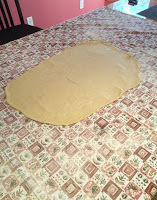
With that foundation as my cheerleader, I kept working the dough until it was like a thin veil that covered the history on that table. At one point, I somehow knew it was time to move on, to sprinkle on more flavors, roll everything together, put it in the oven, and see how it came out. Then it was time to start over again with the second ball of dough, then the third. Each time, I was armed with more knowledge and more confidence, yet until the ball became a sheer sheet, I didn’t know if I was capable of doing it again then again.
 Nearly 6 hours after I first started (don’t ask about the giant oil spill), when I dissected the last lengths of cooked strudel and I took a bite, I realized I had shared some history with those whose path I’d followed. And it tasted wonderful.
Nearly 6 hours after I first started (don’t ask about the giant oil spill), when I dissected the last lengths of cooked strudel and I took a bite, I realized I had shared some history with those whose path I’d followed. And it tasted wonderful.
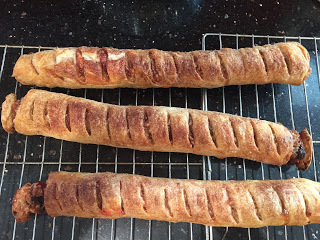
I had happened, once, on my grandmother while she was making strudel, and I had sort of helped my mom do this a couple times, but I’d never taken part in the process from beginning to delicious end. With neither of them here to guide me, I struck out on my own.
I had a recipe, sure. Like many complicated recipes passed down from generation to generation, though, I had an ingredient list and I had an outline of steps, but the important details were missing. (I was lucky actually. Some of my grandmother’s recipes are ingredient lists only.)
I jumped into the process this past Sunday.
The filling was easy; just mix up everything then adjust for taste. It was the dough, the part that held it all together, that would be the ultimate challenge. The thin layers that wrap around the filling start out as flour and water and other ingredients which you mix then let sit for an hour. I won’t go into details, but here’s my first batch of dough.

I needed to figure out where I went wrong.
I took a shower.
And as showers often do, this one worked again. Thinking about my grandmother’s simple instructions—knead dough, divide into thirds, brush with oil, and rest on board for 60 minutes—I realized that similar to bread dough (though this has no yeast), she must have kneaded in more flour than the recipe called for. I probably worked in at least another cup, and this batch had substance. Again, I let it rest to prepare for what was to come.

That one time I walked into my grandmother’s apartment, I couldn’t comprehend how such a small ball of dough could eventually be stretched enough to hang over the edges of her kitchen table like a second tablecloth. And now it was my turn to coax my ball of dough into the same thinness. As it grew and grew and took the shape it needed, I was suddenly struck by the fact that, underneath it all, I began to see the pattern of the tablecloth, one that’s older than me, with all its memories and emotions.

With that foundation as my cheerleader, I kept working the dough until it was like a thin veil that covered the history on that table. At one point, I somehow knew it was time to move on, to sprinkle on more flavors, roll everything together, put it in the oven, and see how it came out. Then it was time to start over again with the second ball of dough, then the third. Each time, I was armed with more knowledge and more confidence, yet until the ball became a sheer sheet, I didn’t know if I was capable of doing it again then again.
 Nearly 6 hours after I first started (don’t ask about the giant oil spill), when I dissected the last lengths of cooked strudel and I took a bite, I realized I had shared some history with those whose path I’d followed. And it tasted wonderful.
Nearly 6 hours after I first started (don’t ask about the giant oil spill), when I dissected the last lengths of cooked strudel and I took a bite, I realized I had shared some history with those whose path I’d followed. And it tasted wonderful.
Published on November 11, 2015 04:11
November 10, 2015
Mom Thornton’s Chili with Steve’s ‘BAMs!’By Marcia Thornt...
Mom Thornton’s Chili with Steve’s ‘BAMs!’
By Marcia Thornton Jones
This is the time of year that I start pulling out ‘family favorite’ recipes. What would Thanksgiving be without sweet potato casserole topped with melted marshmallows? What would Christmas be without sugar cookies or Irish cream truffle fudge?
Flipping through my binder full of recipes is like turning the pages of a photo album. I can see Dad standing by the stove, patiently turning the chicken when making his spicy fried chicken, and feel the steam rising up to fog his glasses. I can see Mom rolling out dough, thin and even, and smell the cinnamon of my brother’s favorite apple pie. I can hear the sizzle of chicken-fried-steak in the electric skillet and the rattle of the cookie jar that Grandma filled with sugar cookies just for us.
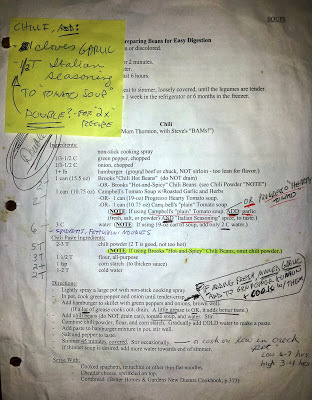 Most memories I can never taste again because the people are gone (and I don’t cook the way they did). But I must admit that as the days grow shorter and cooler, the little girl in me craves one of Mom’s recipes because, really, what would fall be without her chili? Just the thought of it makes me feel cozy, warm, and safe.
Most memories I can never taste again because the people are gone (and I don’t cook the way they did). But I must admit that as the days grow shorter and cooler, the little girl in me craves one of Mom’s recipes because, really, what would fall be without her chili? Just the thought of it makes me feel cozy, warm, and safe.As with most recipes, Mom’s chili has changed a bit over the years. My husband Steve has experimented by adding pinches of this and that until Mom’s really good recipe became great. That sounds a lot like the revision process, doesn’t it? Where we, as writers, take a good story and make it even better? My recipe even looks a bit like an edited page of one of my manuscripts!
This makes me wonder…what are my story character’s favorite foods? What tastes and fragrances would elicit emotions of warmth, comfort, safety, and unconditional love? What might she eat when she’s happy? Depressed? Angry? What food would she stash under her bed? What would she never-ever-ever eat—even on a dare?
How about your characters? What foods might they hide in their sock drawers? Care to share?
Published on November 10, 2015 05:40
November 8, 2015
Craving Meat For A Feast --- by Jane Kelley
Full disclosure: I love eating tofu. I had some last night. If I do eat meat, I prefer it to be fish or poultry. (I adore Charlotte's Web.) But this post isn't meant to pass judgment about what anyone might actually eat. It's about creating a story people will devour.
So, the other day, I was rewriting a middle-grade novel. No surprise. I'm usually rewriting a middle-grade novel. My agent's main feedback was that I needed to raise the suspense. My villain wasn't as menacing as he should be. So I was adding a scene where he called my young heroine. Then I thought, wait, why am I allowing technology to put distance between them? My villain needs to go to her house! My villain needs to back her in a corner! My villain needs to be a real threat!
That started me thinking. All too often, when I'm writing, I pull back from the blood and the guts. It's like I don't want to hurt any humans or animals in the process of making my story. I don't want to get dirty by gnawing the bone.
Sure it's harder to describe an intense fight scene. I've written plenty of passages that inspire more cringes than chills. But that's no excuse. I can write a more delectable scene by following the advice of great cooks. Start fresh. Avoid pre-processed foods. Shun pale substitutes. Spice it up. Be bold!
Which plate makes you hungry for more of the story?
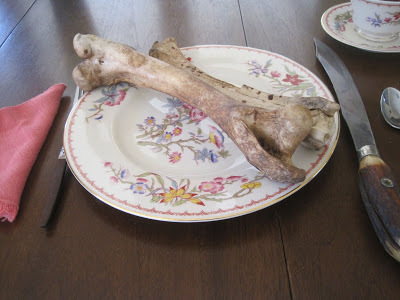
Or this one?

Enjoy the feast!
In case you're wondering, the boys who live next door found those bones in our woods. They probably came from a deer. Unless you'd like to think of a better story.
So, the other day, I was rewriting a middle-grade novel. No surprise. I'm usually rewriting a middle-grade novel. My agent's main feedback was that I needed to raise the suspense. My villain wasn't as menacing as he should be. So I was adding a scene where he called my young heroine. Then I thought, wait, why am I allowing technology to put distance between them? My villain needs to go to her house! My villain needs to back her in a corner! My villain needs to be a real threat!
That started me thinking. All too often, when I'm writing, I pull back from the blood and the guts. It's like I don't want to hurt any humans or animals in the process of making my story. I don't want to get dirty by gnawing the bone.
Sure it's harder to describe an intense fight scene. I've written plenty of passages that inspire more cringes than chills. But that's no excuse. I can write a more delectable scene by following the advice of great cooks. Start fresh. Avoid pre-processed foods. Shun pale substitutes. Spice it up. Be bold!
Which plate makes you hungry for more of the story?

Or this one?

Enjoy the feast!
In case you're wondering, the boys who live next door found those bones in our woods. They probably came from a deer. Unless you'd like to think of a better story.
Published on November 08, 2015 03:00
November 5, 2015
Writing without a Recipe by Deborah Lytton - November Theme
Writing fiction is like cooking without a recipe. My sister is a wonderful cook. Everything she makes is truly delicious (seriously, just thinking about Thanksgiving at her house makes me hungry). And whenever I ask her what recipe she used to make a certain dish, she gives me the same answer--she didn't use one. My sister cooks by instinct.
This is the way I write. I don't like to follow the rules and add just a pinch of this or a dash of that. Because I want my writing to have a uniqueness that belongs to me. If you have ever read any of my posts about outlining, you already know that I don't outline because it limits my creativity. I also don't like to follow rules. In my day job, I am a practicing attorney so I have a professional responsibility to follow rules. This is why I look at writing as an escape, and with that escape, the freedom to break rules.
So if you are like me, and you are a rule-follower by day, I challenge you to break rules in your writing. Play with fragments, made up words, even mixed metaphors. See where your creativity takes you. Maybe you will stir up something delicious!
This is the way I write. I don't like to follow the rules and add just a pinch of this or a dash of that. Because I want my writing to have a uniqueness that belongs to me. If you have ever read any of my posts about outlining, you already know that I don't outline because it limits my creativity. I also don't like to follow rules. In my day job, I am a practicing attorney so I have a professional responsibility to follow rules. This is why I look at writing as an escape, and with that escape, the freedom to break rules.
So if you are like me, and you are a rule-follower by day, I challenge you to break rules in your writing. Play with fragments, made up words, even mixed metaphors. See where your creativity takes you. Maybe you will stir up something delicious!
Published on November 05, 2015 22:43
November 3, 2015
Recipe for a Good Book by Irene Latham
I love to cook. So it's no surprise that food sometimes comes up in my books.
In LEAVING GEE'S BEND, reader letters often mention the big breakfast Ludelphia has at Mrs. Cobb's house -- where she also drinks a coke for the very first time! When I visit book clubs, refreshments often include Coke and Ludelphia's Lemon Pound Cake, a recipe adapted from my Grandma Dykes's recipe. It's old-school, dense, moist, delicious. Yum!
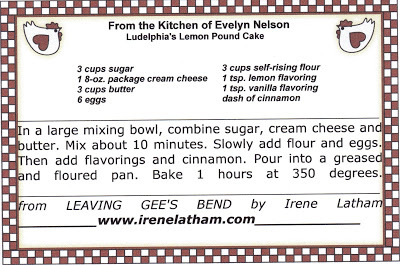
More recently, I've written a collection of short, lyrical, imaginative poems about tomatoes, cucumbers, okra, peaches, and more called FRESH DELICIOUS: Poems from the Farmers' Market. It's releasing March 8, 2016, from WordSong/Boyds Mills Press with charming illustrations by Mique Moriuchi. I'm currently planning a Farmers' Market tour. Because what's better than books & food?!
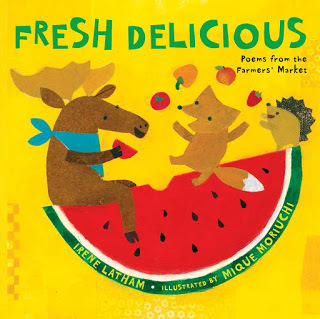
Finally, here is a poem I wrote called "Recipe for a Good Book." I wanted it works for readers AND for writers. Still working on it. Enjoy!
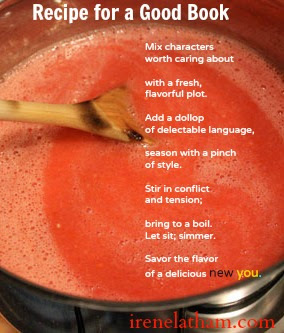
Recipe for a Good Bookby Irene Latham
Mix charactersworth caring about
with a freshflavorful plot.
Add a dollopof delectable language,
season with a pinchof style.
Stir in conflictand tension;
bring to a boil.Let sit; simmer.
Savor the flavorof a delicious new you.
- Irene Latham
In LEAVING GEE'S BEND, reader letters often mention the big breakfast Ludelphia has at Mrs. Cobb's house -- where she also drinks a coke for the very first time! When I visit book clubs, refreshments often include Coke and Ludelphia's Lemon Pound Cake, a recipe adapted from my Grandma Dykes's recipe. It's old-school, dense, moist, delicious. Yum!

More recently, I've written a collection of short, lyrical, imaginative poems about tomatoes, cucumbers, okra, peaches, and more called FRESH DELICIOUS: Poems from the Farmers' Market. It's releasing March 8, 2016, from WordSong/Boyds Mills Press with charming illustrations by Mique Moriuchi. I'm currently planning a Farmers' Market tour. Because what's better than books & food?!

Finally, here is a poem I wrote called "Recipe for a Good Book." I wanted it works for readers AND for writers. Still working on it. Enjoy!

Recipe for a Good Bookby Irene Latham
Mix charactersworth caring about
with a freshflavorful plot.
Add a dollopof delectable language,
season with a pinchof style.
Stir in conflictand tension;
bring to a boil.Let sit; simmer.
Savor the flavorof a delicious new you.
- Irene Latham
Published on November 03, 2015 03:30
November 2, 2015
H.G. and Annie D. By Ann Haywood Leal
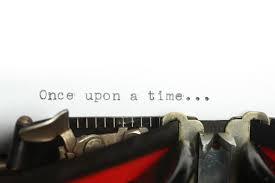
 Annie Dillard says, “ . . . spend it all, shoot it, play it, lose it, all, right away, every time. Do not hoard what seems good … give it, give it all, give it now. Something more will arise for later, something better.” This wisdom has become one of my favorite recipes for writing.
Annie Dillard says, “ . . . spend it all, shoot it, play it, lose it, all, right away, every time. Do not hoard what seems good … give it, give it all, give it now. Something more will arise for later, something better.” This wisdom has become one of my favorite recipes for writing.I love this, because I am guilty of saving my writing. But really, for what am I saving it? A perfectly good idea can end up like back-of-the-refrigerator food--something that was perfectly good on Saturday, but ended up getting stashed away and wasted by next Friday. I have a million little notebooks—I always have one going, as do most of the writers I know. But if a good line comes to you—or a great character idea—or some fantastic setting details, find a way to put it in right now. Don’t let it disappear forever into the pages of your journal; get it down on a page of your book.
H.G. Wells had another great writing recipe. He said, “If you are in difficulties with a book, try the element of surprise; attack it at an hour when it isn’t expecting it.”
 I am a big proponent of writing at the same time every day. It may just be a mind game that I play with myself, but I truly believe that my body and mind get used to this 5:00 a.m. time. The words automatically start trickling out after I’ve had my first few sips of coffee. The routine of it all works for me. However, we have all gotten to a point in our story where either we, or the story feels stagnant. So try again. Try it at 5:00 p.m., instead. If you are too tired at this time, because your first writing time of the day was at 5 a.m., go for a walk. Let the ideas start to flow. Do what makes your mind wander to your story. Walking, running, riding your bike, cooking, baking, knitting…be open to it, and your characters might just start talking to you.
I am a big proponent of writing at the same time every day. It may just be a mind game that I play with myself, but I truly believe that my body and mind get used to this 5:00 a.m. time. The words automatically start trickling out after I’ve had my first few sips of coffee. The routine of it all works for me. However, we have all gotten to a point in our story where either we, or the story feels stagnant. So try again. Try it at 5:00 p.m., instead. If you are too tired at this time, because your first writing time of the day was at 5 a.m., go for a walk. Let the ideas start to flow. Do what makes your mind wander to your story. Walking, running, riding your bike, cooking, baking, knitting…be open to it, and your characters might just start talking to you.
Published on November 02, 2015 01:00
October 31, 2015
FEAR, INDIE PUBLISHING, AND FINDING THE FUN IN IT ALL (HOLLY SCHINDLER)
This year, in addition to working on my next MG novel, I also took the indie plunge. The scariest part of doing independent work is that it’s 100% yours. There’s no publishing house making decisions about category or cover. Everything—from the concept to the execution, first line to jacket copy, is you.
Once you’ve opened the door to being a hybrid author, it also generally means you have no excuses for not tackling that project dangling out there. You know the one—that one you’ve ALWAYS wanted to explore but never have, because you know there’s no slot in the traditional marketplace for it.
That was the case with the sequel to my YA romance, PLAYING HURT. When PLAYING HURT released, readers immediately started asking me what happened during Chelsea and Clint’s second summer. But I knew, even then, that I really wanted to pick up with Chelsea four years later, rather than the very next summer…I wanted to explore the possibility of whether that youthful romance—you know the one…that hot short intense fling you had that’s never really left your mind completely—if THAT could ever become a lasting relationship.
But that was always problematic, for a hundred different reasons. PLAYING HURT featured an eighteen and nineteen-year-old. Four years later, they were twenty-two and twenty-three…and the house that released PLAYING HURT is a strictly YA-only house…and then HarperCollins (rather than Flux) started publishing my YAs, and…
You see where this is going. One excuse piled on top of another. Well—maybe not excuses. They’re all valid reasons not to tackle a book that’s never going to see the light of day in the traditional world. Once I opened the hybrid door, though, all these reasons really did become excuses. As a hybrid author, if I didn’t do the PLAYING HURT sequel, that was also 100% on me.
…Was picking up with a story I hadn’t touched for four years frightening, too? Absolutely.Was it scary to release a sequel to a book that readers were emotionally attached to? Yes.
But fear, if viewed at the right angle, is fun, too. After all, that’s what Halloween is for.
Happy Halloween!
PLAYING HURT:
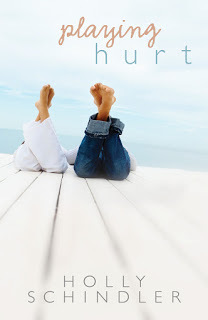 Star basketball player Chelsea "Nitro" Keyes had the promise of a full ride to college—and everyone's admiration in her hometown. But everything changed senior year, when she took a horrible fall during a game. Now a metal plate holds her together and she feels like a stranger in her own family.
Star basketball player Chelsea "Nitro" Keyes had the promise of a full ride to college—and everyone's admiration in her hometown. But everything changed senior year, when she took a horrible fall during a game. Now a metal plate holds her together and she feels like a stranger in her own family.
As a graduation present, Chelsea's dad springs for a three-week summer "boot camp" program at a northern Minnesota lake resort. There, she's immediately drawn to her trainer, Clint, a nineteen-year-old ex-hockey player who's haunted by his own traumatic past. As they grow close, Chelsea is torn between her feelings for Clint and her loyalty to her devoted boyfriend back home. Will an unexpected romance just end up causing Chelsea and Clint more pain—or finally heal their heartbreak?
PLAY IT AGAIN:

A Second Chance at First Love (A Playing Hurt Novel)Four years ago, Chelsea and Clint had both seen their share of tragedy. Will their second chance at love end in triumph…or will it be yet another heartbreak?
Chelsea was a teenage small town celebrity—a basketball star with the promise of a free ride to college…until an accident on the court shattered her hip and her dreams. Clint was a high school Minnesota hockey player whose first love died in a car accident on the way to one of his pond tournaments; head no longer in the game, Clint was forced to hang up his skates.
On a family vacation to Minnesota, Chelsea met Clint, a fishing guide and personal trainer at her resort. Through their overwhelming, inexplicable, and undeniable whirlwind romance, they began to heal each other—to discover their own strength and resilience. Their summer together was short, but it bubbled over in intensity: stolen kisses, passionate meetings under starlit skies, lovemaking to the beat of a cascading waterfall. And it ended with the promise of a second summer.
Life got in the way, thwarting their plans. Now, four years later, the compass of Chelsea’s heart is pointing her back to Minnesota—toward the strongest love of her life. But can that original heat be reignited, or will old wounds snuff out any chance at rekindling their original passion?
Play It Again picks up as Chelsea’s and Clint’s paths cross again to explore issues of forgiveness and second chances, and to ask whether true, lasting adult love can grow from the fires of youthful passion.
Once you’ve opened the door to being a hybrid author, it also generally means you have no excuses for not tackling that project dangling out there. You know the one—that one you’ve ALWAYS wanted to explore but never have, because you know there’s no slot in the traditional marketplace for it.
That was the case with the sequel to my YA romance, PLAYING HURT. When PLAYING HURT released, readers immediately started asking me what happened during Chelsea and Clint’s second summer. But I knew, even then, that I really wanted to pick up with Chelsea four years later, rather than the very next summer…I wanted to explore the possibility of whether that youthful romance—you know the one…that hot short intense fling you had that’s never really left your mind completely—if THAT could ever become a lasting relationship.
But that was always problematic, for a hundred different reasons. PLAYING HURT featured an eighteen and nineteen-year-old. Four years later, they were twenty-two and twenty-three…and the house that released PLAYING HURT is a strictly YA-only house…and then HarperCollins (rather than Flux) started publishing my YAs, and…
You see where this is going. One excuse piled on top of another. Well—maybe not excuses. They’re all valid reasons not to tackle a book that’s never going to see the light of day in the traditional world. Once I opened the hybrid door, though, all these reasons really did become excuses. As a hybrid author, if I didn’t do the PLAYING HURT sequel, that was also 100% on me.
…Was picking up with a story I hadn’t touched for four years frightening, too? Absolutely.Was it scary to release a sequel to a book that readers were emotionally attached to? Yes.
But fear, if viewed at the right angle, is fun, too. After all, that’s what Halloween is for.
Happy Halloween!

PLAYING HURT:
 Star basketball player Chelsea "Nitro" Keyes had the promise of a full ride to college—and everyone's admiration in her hometown. But everything changed senior year, when she took a horrible fall during a game. Now a metal plate holds her together and she feels like a stranger in her own family.
Star basketball player Chelsea "Nitro" Keyes had the promise of a full ride to college—and everyone's admiration in her hometown. But everything changed senior year, when she took a horrible fall during a game. Now a metal plate holds her together and she feels like a stranger in her own family.As a graduation present, Chelsea's dad springs for a three-week summer "boot camp" program at a northern Minnesota lake resort. There, she's immediately drawn to her trainer, Clint, a nineteen-year-old ex-hockey player who's haunted by his own traumatic past. As they grow close, Chelsea is torn between her feelings for Clint and her loyalty to her devoted boyfriend back home. Will an unexpected romance just end up causing Chelsea and Clint more pain—or finally heal their heartbreak?
PLAY IT AGAIN:

A Second Chance at First Love (A Playing Hurt Novel)Four years ago, Chelsea and Clint had both seen their share of tragedy. Will their second chance at love end in triumph…or will it be yet another heartbreak?
Chelsea was a teenage small town celebrity—a basketball star with the promise of a free ride to college…until an accident on the court shattered her hip and her dreams. Clint was a high school Minnesota hockey player whose first love died in a car accident on the way to one of his pond tournaments; head no longer in the game, Clint was forced to hang up his skates.
On a family vacation to Minnesota, Chelsea met Clint, a fishing guide and personal trainer at her resort. Through their overwhelming, inexplicable, and undeniable whirlwind romance, they began to heal each other—to discover their own strength and resilience. Their summer together was short, but it bubbled over in intensity: stolen kisses, passionate meetings under starlit skies, lovemaking to the beat of a cascading waterfall. And it ended with the promise of a second summer.
Life got in the way, thwarting their plans. Now, four years later, the compass of Chelsea’s heart is pointing her back to Minnesota—toward the strongest love of her life. But can that original heat be reignited, or will old wounds snuff out any chance at rekindling their original passion?
Play It Again picks up as Chelsea’s and Clint’s paths cross again to explore issues of forgiveness and second chances, and to ask whether true, lasting adult love can grow from the fires of youthful passion.
Published on October 31, 2015 05:00



